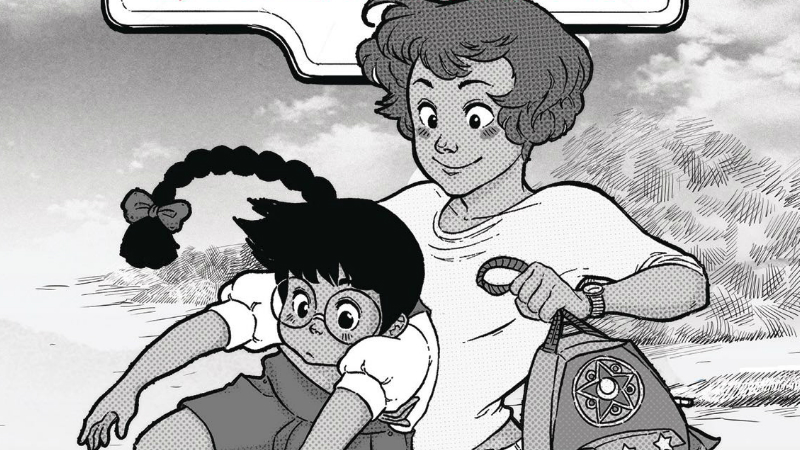
Queen Street Review
Creator: Emmanuelle Chateauneuf
Publisher: Chapterhouse Comics
A review by Billy Seguire
 There’s a magic in childhood. A child has the potential to imagine limitless possibilities, yet is consistently undervalued in their capacity to observe the world around them. Presented with that in mind, Queen Street is a gorgeous black-and-white graphic novel depicting twelve hours in the life of a mother and daughter in Sault Ste. Marie as they struggle with their identities as immigrants, women, and family. Emmanuelle Chateauneuf demonstrates a strong creative vision for a book that deals head on with the figures of her own past. A heartbreakingly sweet story with genuine empathy for all of its characters, Queen Street doesn’t indulge in the saccharine, but revels in genuine human moments that make this modern fairy tale ring true.
There’s a magic in childhood. A child has the potential to imagine limitless possibilities, yet is consistently undervalued in their capacity to observe the world around them. Presented with that in mind, Queen Street is a gorgeous black-and-white graphic novel depicting twelve hours in the life of a mother and daughter in Sault Ste. Marie as they struggle with their identities as immigrants, women, and family. Emmanuelle Chateauneuf demonstrates a strong creative vision for a book that deals head on with the figures of her own past. A heartbreakingly sweet story with genuine empathy for all of its characters, Queen Street doesn’t indulge in the saccharine, but revels in genuine human moments that make this modern fairy tale ring true.
While there are clearly autobiographical notes in Queen Street, Chateauneuf has crafted her childhood memories into an elegant story, providing a concise but encompassing snapshot of a time when she saw the struggles her mother in a different light. An independent, stubborn woman from the Philippines, Aimee finds the Canadian experience to not be what she expected. Immigration in particular is integral to this story, with Aimee coming from wealth and prosperity back home to discrimination and constant financial struggles in Canada. To add extra strain to this relationship, Melodie is abnormally intelligent for her age, noticing the adults talking about her and seemingly understanding the emotional strain without fully grasping the situation as a whole. A heartbreaking sequence of Melodie asking her mother if she needs to quit dancing so they won’t be homeless sets a tone early on. Aimee might find life in Canada difficult compared to how she lived back home, but she would do anything for the good of her daughter.
Like a majority of the work Chapterhouse produces, Queen Street offers a strong sense of Canadian identity. Emmanuelle Chateauneuf has clearly been given the freedom in Queen Street to tell her own personal outsider story the way she sees fit, and the parallels between mother and daughter in the way they both find themselves isolated in Canada makes for a compelling premise that demonstrates what makes Canadian storytelling so powerful. It’s fantastic for a culture that celebrates our immigrants to tell a story that isn’t a depiction of the idealised dream. The slice-of-life story is more complicated than that, and better for it.
There are hardly any moments when Queen Street feels like it stumbles in recreating a child’s perspective. Melodie is one of the most interesting child protagonists I’ve encountered in a while and I love the way Chateauneuf treats her imagination with the same level of importance to Melodie as her reality. While the subject matter is consistently grounded, Chateauneuf gives Queen Street a magical quality through Melodie’s active imagination that gives the creator the opportunity to fill this story with mermaids, princesses, and Tarzan-inspired jungle hunters. These sequences give Queen Street a flowery sense of life. Melodie and her mother are perfectly paired against each other and the world is populated with larger than life characters who have towered over Chateauneuf’s childhood memories. This chemistry between these characters makes it all the more impressive that the main narrative is able to tell this story so well in so few pages.
Beyond her mother, Melodie spends her childhood surrounded by a community of women. Each are given enough room on the page to exist as a whole, thriving person without lumping any one attribute together. Her grandmother is one of these women who fights for Melodie. She disapproves of some of the decisions her daughter-in-law makes but nevertheless tells Aimee she’s doing a better job than most mothers would in her position. Likewise, Aimee’s neighbor Pat is a washed up alcoholic, but as we see at the end of the book, she’s a woman who will go out of her way to support those she cares about. It’s a credit to Emmanuelle Chateauneuf and the intelligence of her main characters that these women come off so well-rounded and realistic, with each detail noticed by Melodie, silently observing situations as they unfold. One memorable sequence features a call from Melodie’s absent father, a long-haul truck driver. We never see Joseph, but witness the conversation exclusively through both Aimee and Melodie’s perspectives.
The art of Queen Street also adds so much in terms of tone. This is a character story, and as such the art is concentrated on creating memorable, visually distinct characters that stand out from one another on the page. Melodie has an endearingly cute design. Her round glasses and wide, gap toothed smile make her cute and friendly, and during the ballet sequence we see her body is underdeveloped compared to the other girls, emphasising how much of a child she is intended to be. These facts help us relate with Melodie, but also keeps her distinct as we see her escape into her own head in wondrous dreamlike sequences. For instance, a scene of Melodie in the bathtub becomes a mermaid battleground, and a sequence of Melodie playing with a toy unicorn culminates in an incredible splash page depicting her as a princess in a page filled with many elegant details.
There’s an instantly recognisable use of the manga genre in Chateauneuf’s art for Queen Street, and a Ghibli influence to Queen Street’s tone that works to support the magical quality of both the art and story. Soft greys allow the line art to shine while adding depth, and rounded figures help to give shape to a past coloured through a nostalgic filter, stunningly complimented by Chateauneuf’s contrast between the differing worlds of child and adult. Chateauneuf shows how these whimsical departures from reality separate Melodie from the rest of the characters in the book.
While the story ends somewhat abruptly, the fact that it leaves the characters on such an open note emphasizes that there is a wealth of stories to be told in this world, and by focussing on a highly specific point in time, Chateauneuf only offers readers a glimpse into the full life story of these characters. The shorter, newspaper-strip style comics at the end of the book provide a different experience that still feels connected to the work as a large, interconnected narrative in the story of Melodie and Aimee as they make their way through Canadian life together.
The Verdict
Buy It! Emmanuelle Chateauneuf has produced a charming, meaningful story in Queen Street that succeeds with the aid of an imaginative and magical presentation. There are equal parts joy and struggle in this book, and it’s impressive how well Queen Street is able to fairly balance its dual protagonists of Melodie and Aimee. Giving equal weight to the occasionally conflicting perspectives, Chateauneuf cuts through the ways characters present themselves to give readers a full picture of events as they play out. The clear creative voice, soft greys, and exquisite details of her art makes the heart of the story shine. While Melodie’s intelligence and occasionally invasive observations are a struggle for her mother, they also archive that struggle through a period where it’s clear Aimee is doing everything she can to provide her daughter with the life she deserves. Chateauneuf has done her story proud.
Queen Street comes out on August 30th, 2017




One thought on “Queen Street Review”